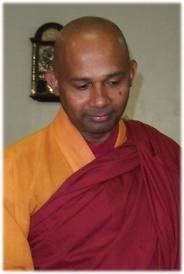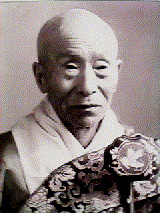Step Eight – Both Self and Ox Forgotten
The Third Dharma Realm
Whip, rope, person, and bull — all merge in No-Thing. This heaven is so vast no message can stain it. How may a snowflake exist in a raging fire? Here are the footprints of the patriarchs.
The third dharma realm is the dharma realm of the Pratyeka Buddhas.
The central practice is to apply the super power mindfulness developed by the above steps to the Doctrine of Dependent Arising.
The Pratyeka Buddha is defined as a being who attains Buddhahood even when there is no Buddha in the world. In other words, a Pratyeka Buddha is a self-taught Buddha.
However, Pratyeka Buddhas can also arise when there is a Buddha in the world. They are then considered to be beings enlightened by conditions.
Just as the realm of the hungry ghost is perhaps best understood as being a transitional realm between the hell realm and the animal realm, we can also think of the Pratyekabuddhas as occupying a realm above that of the Arhats but below that of the Bodhisattvas.
Master Yasutani says: At the eighth stage, we come to realize the fact that this “I” (self), which has been seeking, and the essential self (ox), which has been the object of our search, did not exist at all. Thus, both self and ox are forgotten.
Harada Roshi, teacher of Yasutani Roshi
(1871-1961)
This isn’t the kind of statement we can understand with the critical thinking mind. For us to say that neither we nor our minds exist is nonsense to our rational, thinking mind.
The original set of the Ox-Herding Pictures ended with the eighth “drawing.” It was a blank space, indicating that anything that was depicted about the eighth and final stage would be misleading.
“This heaven is so vast, no message can stain it” means that any words or drawings about the eighth and final stage were meaningless. Words and drawings are mere snowflakes that can’t exist in a raging fire.
The circle (enso) indicating no beginning of practice and no ending to enlightenment was added as the eighth drawing when the eight Ox-Herding Pictures were augmented to include the ninth and tenth drawings.
Apparently, the augmentation took place when someone decided that forgetting the self and the ox, i.e., eliminating the duality between self and goal, placed the practitioner not in nirvana but in the neighborhood of nirvana.
The ninth step of reaching or returning to the source was added as was the tenth step of returning to the marketplace to indicate that the ideal of the Bodhisattva – teaching and helping others while refraining from entering into Nirvana until all others have done so as a result of such teaching – was the true final step, not Buddahood.
However, we rank the first dharma realm of the Buddhas above the second dharma realm of the Bodhisattvas. Ranking a Bodhisattva above a Buddha seems to be part of the Mahayana’s attempts to “trump” the “Hinayana” or “lesser vehicle” (Theravada) by announcing that one who returns to teach is above a Buddha who simply disappears into Nirvana.
A Bodhisattava, however, is a Buddha-to-be, so it is hard to see how a future Buddha is to be more revered than an actual Buddha. And the Mahayana assertion that a Theravada Buddha vanishes and becomes meaningless but that a Mahayana Buddha returns to teach and to rescue beings from the hell realms – which a Theravada Buddha supposedly doesn’t do – seems to emanate from an ill will toward the “Hinayana.”
I have attended so-called Buddhist events at Thai (Theravada) temples where the slaughtered bodies of animals are served up in copious quantities, and I certainly understand the origins of the Mahayana disdain for the Theravadans.
If the Theravadans would start following the precept against killing, the two major schools of Buddhism could re-unite. Both schools could then practice Theravada tranquil wisdom meditation to develop the super power mindfulness needed to see the doctrine of dependent arising, both forward and backward, and to solve Mahayana/Zen koans.
Just as the Christians have limited “Thou Shalt Not Kill” by interpreting that commandment to mean “Thou Shalt Not Kill Human Beings And Even That Is OK When The Government Wants A War And Thou Shalt Kill All Animals That Thou Thinketh To Be Tasty When Cooked,” (real carnivores eat meat raw) so have the Theravadans limited the first precept to non-killing of human beings.
The Buddha, who used the strongest terms when condemning the wanton slaughter of animals, mentions multiple times in the Pali Canon that an enlightened being sees dependent arising, both forward and backward, and that no enlightenment has occurred if the being has not seen dependent arising, both forward and backward.
Intellectually understanding the Doctrine of Dependent Arising/Origination has nothing at all to do with knowledge of the doctrine in the conventional sense. True understanding is non-intellectual and arises from having coursed through the four dhyanas/jhanas and the four immaterial attainments and applying the super power mindfulness so developed to the doctrine in a non-intellectual, non-verbal way.
There are a number of sutras/suttas that mention the Doctrine of Dependent Origination. The Buddha said that to understand the Doctrine of Dependent Origination is to understand the Four Noble Truths.
The hyperlinked article is lengthy but well worthy of our study at the Advanced Zen level. It is also available in book form under the title Dependent Origination: Buddhist Law of Conditionality.
In a verbal way, this is the doctrine in the forward or arising direction:
1-2. From ignorance (avijja) arises volition (sankhara); (avijja paccaya sankhara)
2-3. From volition (sankhara) arises consciousness (vinnana); (sankhara paccaya vinnanam)
3-4. From consciousness (vinnana) arises body and mind (nama-rupa); (vinnana paccaya nama-rupam)
4-5. From body and mind (nama-rupa) arises the six senses (salayatana); (nama-rupa paccaya salayatanam)
5-6. From the six senses (salayatana) arises contact (phassa); (salayatana paccaya phassa)
6-7. From contact (phassa) arises feeling (vedana); (phassa paccaya vedana)
7-8. From feeling (vedana) arises craving (tanha); (vedana paccaya tanha)
8-9. From craving (tanha) arises clinging (upadana); (tanha paccaya upadanam)
9-10. From clinging (upadana) arises becoming (bhava);
(upadana paccaya bhava)
10-11. From becoming (bhava) arises birth (jati); (bhava paccaya jati) and
11-12. From birth (jati) arises old age and death (jaramaranam); (jata paccaya jaramaranam).
From old age and death (jaramaranam) arises sorrow, lamentation, pain, grief and despair (soka-parideva-dukkha-domanassupayasa nirujjhan’ti). (jaramaranam paccaya soka-parideva-dukkha-domanassupayasa nirujjhan’ti)
Here is the doctrine in the ceasing direction:
1-2. When ignorance (avijja) ceases, then volition (sankhara) ceases;
2-3. When volition (sankhara) ceases, then consciousness (vinnana) ceases;
3-4. When consciousness (vinnana) ceases, then mentality-materiality (mind and body) (namarupa) ceases;
4-5. When mentality-materiality (mind and body) (namarupa) ceases, the six sense bases (salayatana) cease;
5-6. When the six sense bases (salayatana) cease, then contact (phassa) ceases;
6-7. When contact (phassa) ceases, then feelings (vedana) cease;
7-8. When feelings (vedana) cease, then cravings (tanha) cease;
8-9. When craving (tanha) ceases, then clinging (upadana) ceases;
9-10. When clinging (upadana) ceases, then becoming (bhava) ceases;
10-11. When becoming (bhava) ceases, then birth (jati) ceases; and
11-12. When birth (jati) ceases, then old age and death (jaramaranam) cease.
When old age and death cease, then sorrow, lamentation, pain, grief and despair (soka-parideva-dukkha-domanassupayasa nirujjhan’ti) cease.
The Buddha defined Nirvana as the highest happiness.
By the way, he never said “old age, sickness and death.” He said “old age and death.”
Sickness is optional.
Palolo Zen Center, home of the Honolulu Diamond Sangha



